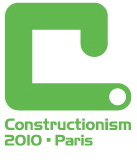Ceci est une publication scientifique présentée lors de la conférence « Constructionism 2010« , en anglais, organisée par James CLAYSON de l’Université Américaine de Paris.
J’y décris en détail un exercice que j’ai inventé et pratiqué de nombreuses années auprès des étudiants de 1ère année de Strate Collège.
Abstract :
This paper describes a pedagogic exercise given to designers to be (1st year), within a communication class. The exercise is only based on the use of 6 given images.
The exercise takes place after two sessions, the first of which being devoted to the participative construction of the famous communication diagram (emitter, coding, channel + noise, decoding, receiver).
In the second session, starting with this diagram, the emitter is then replaced by “the world” and the receiver by “you”. With the help of this redefined diagram, “demonstrate” the students that the first limit of our communication with the world is to be found in our perception mechanisms, and that, in that respect, we are always abstracting, and that what we call « reality » is literally and technically an abstraction.
To free ourselves from this prison, we then “demonstrate” to the students that the only way to go beyond the limits of our perception is to build theories, through which it is then possible to discover all the hidden dimensions of the world.
But, by doing so, we are in reality building a new but even more wicked prison: the prison of our vision of the world. In that respect, we are de facto projecting on the world what we know about it: after being an abstraction, the world is moreover a projection.
The actual exercise demonstrates this second proposition in a very obvious and direct way.
With the help of 6 very simple images including characters and various other representations, we demonstrate, again, that the students are prisoners of theories. This is done by asking them to create a story of their own, using all 6 images, without any other constraints than the images themselves. We urge them to be creative.
When that is done, after one hour, the comparison between all the stories shows clearly and simply that they are projecting what they know about the “theory” of images and narration, thus limiting themselves to a common – and therefore not creative – domain of narration.
After this explanation is given, students are asked again to produce more stories, but this time by freeing them from the theory, and the results are simply astonishing.

